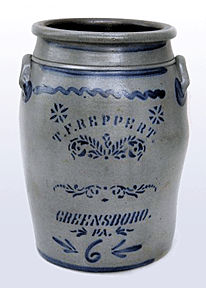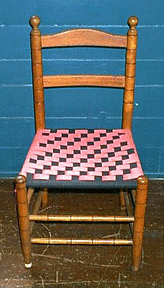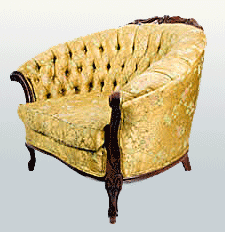Fake, Faux or Repro
by
Bob Brooke

As long as there have been antiques,
there have been fakes and reproductions. But telling the two apart can
often be difficult even to the trained eye of an expert. But antiques,
however, have become fashionable and as a result unscrupulous people are
copying or reproducing them as fast as can be.
Like copies of clothing and jewelry,
many pseudo-antiques are so cheap looking as to be obvious shams. But
there are clever copies, too, on which someone has spent time and effort
to make them look authentically aged. Because fakes and reproductions
look so much like antiques themselves, particularly to those who know
little about the real ones, people who want to buy or sell old things,
should do all they can to learn how genuine or false they are.
Three Groups of
Pseudo-Antiques
Pseudo-antiques fall into one of three groups: cheap imitations, clever
fakes, and sound reproductions. All three have been made to such an
extent during the 20th and 21st centuries that probably every major
group of antiques has been cloned. It’s easy to be fooled, particularly
if the maker crafted the article with intent to deceive, but the most
careful fake is no more comparable to the antique on which someone based
the garish imitations of fine old china and lamps sold in many discount
stores. Their quantity should be one clue to their recent origin. The
details that haven’t been copied carefully enough for them to be
reproductions is another.
 On
the other hand, you’ll often see clever fakes offered as genuine
antiques, particularly in the case of furniture. Old wood taken from an
antique chest and combined with new wood to make another piece is a
practice that’s becoming common, especially in England. And though much
effort has been expended to copy characteristic details of style and to
simulate aged materials, a fake is still a fake. On
the other hand, you’ll often see clever fakes offered as genuine
antiques, particularly in the case of furniture. Old wood taken from an
antique chest and combined with new wood to make another piece is a
practice that’s becoming common, especially in England. And though much
effort has been expended to copy characteristic details of style and to
simulate aged materials, a fake is still a fake.
There is, of course, nothing wrong with a good reproduction as long as
the owner doesn't try to pass it off as a genuine antique. Many
reproductions are such faithful copies that it would be difficult to
tell the difference, if it weren’t for the lack of wear— years of use
and care add special character to any antique. Valuable Austrian
Biedermeir furniture is a good example. World War II destroyed so many
pieces that the art of reproducing them is flourishing. And some of the
reproductions look as good or better than the originals.
Price
is No Guarantee of Authenticity
Price is no
guarantee of authenticity. Some people buy reproductions, particularly
in furniture, because they think they cannot afford genuine antiques.
Actually, reproductions that are careful replicas are about as costly as
the originals. This is as true of a mirror in American Chippendale style
and a brass hanging lantern as it is of important pieces of furniture.
The cost of the labor necessary to produce even a clever fake built of
wood, of which only one-fourth is old and the remainder treated to look
old, is so great that the price must be nearly as much as that for an
antique. Anyone who thinks that a pine spice chest a century or so old
is overpriced at $225 to $350 has only to consult cabinetmakers or
repairers about mending a broken drawer or replacing a missing one to
realize that a reproduction would cost more than an original. Still, no
matter how much a reproduction costs, it cannot be expected to sell for
as high a price as the antique on which it was modeled.
 Reproductions
have been popular for a great many years, but the number of antiques
being reproduced and sold as such has never been greater than at the
present time. Furniture is most widely represented, for there’s not only
a great deal of it but also the examples range from certain styles of
the 17th century through the 18th and into the early Victorian era. All
sorts of household furnishings and accessories from wallpaper and
textiles to pressed glass, silver, and numerous things made of other
metals have proved popular as reproductions, too. Reproductions
have been popular for a great many years, but the number of antiques
being reproduced and sold as such has never been greater than at the
present time. Furniture is most widely represented, for there’s not only
a great deal of it but also the examples range from certain styles of
the 17th century through the 18th and into the early Victorian era. All
sorts of household furnishings and accessories from wallpaper and
textiles to pressed glass, silver, and numerous things made of other
metals have proved popular as reproductions, too.
Comparatively few people know enough about more than one field of
antiques to tell a fake or reproduction from an authentic piece. This is
as true of antique dealers as well as the general public. An antique
dealer who’s an authority on 17th- or 18th-century furniture may have
only superficial knowledge about the pieces made during the Victorian
Era. By the same token, the pressed glass expert may know little about
silver and china.
What, then, can you do? You can study exhibits and collections, learn
from books and other people, look and listen before and during auctions,
compare a questionable piece with an authenticated one. Above all, you
can ask questions of a reputable dealer, of experts such as curators and
others who work with antiques, and of collectors or anyone who has
studied some special field. Collectors usually admit to having bought
one or more fakes or reproductions while they were learning the
distinguishing characteristics of their chosen item. Those people who
think they know more than they do about antiques, who close their minds
to the fact that fakes, imitations, and reproductions exist, are the
ones who get taken with their purchases and end up disappointed about
their discoveries or are fooled in their purchases.
To read
more of my articles, please
visit
my Web site.
<
Back to Antiques Articles
Next Article > |
